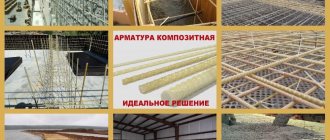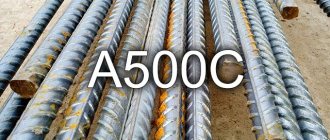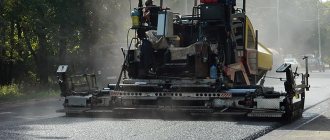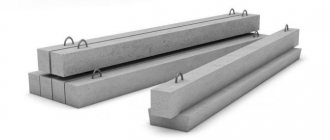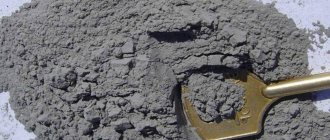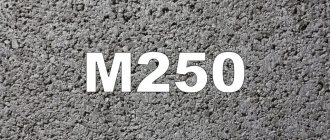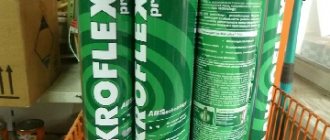Metal reinforcement is considered a reliable option for forming the “skeleton” of monolithic concrete. And today its importance and necessity in construction is not in doubt, although a new type of reinforcement has appeared on the market and is steadily progressing - composite or fiberglass (FRP). The material can be called “new” quite conditionally; it came to the market 50 years ago. For Russia, fiberglass was irrelevant until recently; we have enough resources to produce our own metal at a reasonable price for construction.
At the same time, fiberglass reinforcement has caught up and surpassed metal in a number of properties, and conclusions about the strength and durability of the material can be drawn from global experience in operating spas.
Structure of composite reinforcement
A building material is made from fiberglass fiber impregnated with a polymer binder in the form of relief rods of a given size - fiberglass reinforcement. Material structure:
- Inner rod. Serves to provide basic functional characteristics. Fiberglass fibers are used in production. They are placed in the structure of the rods in parallel or in the form of braided weaving, then filled with polymer resin.
- External covering. It is performed by winding composite fibers onto an internal rod or by spraying a fine abrasive onto it.
Rebar for foundation reinforcement
Traditionally, metal rods were used for reinforcement. Their composite analogues appeared relatively recently, at the end of the second half of the 20th century, and gradually began to replace metal products.
Fiberglass reinforcement
Composite reinforcement, based on the material from which it is made, is divided into the following types:
- glass composite (plastic, fiberglass) - ASC;
- carbon composite – AUK;
- aramidocomposite - AAC;
- basalt composite – ABK;
- combined – ACC.
The first option is most widespread. This is due, on the one hand, to its lower price (compared to analogues), and on the other hand, to acceptable performance properties.
Plastic fittings are made from a mixture of the following materials:
- glass fiber staple;
- polymeric binders, for example, epoxy-diane or epoxy resins;
- additives intended to improve the technical characteristics of products.
The technology for the production of fiberglass products consists of the following algorithm of actions:
- the fiberglass is unwound, forming bundles from it;
- by impregnating them with special binding compounds, the desired cross-section of the products is obtained;
- The bundles treated with a polymer substance are wrapped in a spiral with a fiberglass cord;
- the resulting blanks are polymerized in an oven;
- the rods are cut into fragments of the required length or wound into coils.
Plastic fittings can be smooth or with ribs (profiled).
The fiberglass frame is formed in horizontal rows in the form of a grid, secured at a certain level by vertical jumpers. Longitudinal rods take on the main load, so they are chosen with a larger cross-section and laid in increments of no more than 0.3 m. The distance between the transverse and vertical rods varies from 0.3 to 0.8 m depending on the expected load. Also, their diameter may be smaller than that of longitudinal reinforcement.
The intersections of the rods and the corners are fixed using plastic ties or knitting wire with a cross-section of 0.8-1.2 mm. The last option involves using a special gun or a tying hook. The rods are joined with an overlap.
Plastic fittings are a modern alternative to steel products. The laying of fiberglass rods for reinforcing the base is carried out according to a scheme similar to metal rods.
Standard sizes and parameters
The diameter of the produced spa varies in the range of 4 – 18 mm. Products are produced in the form of measuring rods or in coils.
The total length of the reinforcement in the coil depends on the technological equipment used in its manufacture. Spas with a diameter of 12 mm or more are offered to the consumer exclusively in the form of rods.
The main parameters affecting the scope of application include the weight of one meter and the diameter of the composite rod.
The winding pitch can be considered an additional characteristic, but today almost all manufacturers produce reinforcement with a pitch of 15 mm.
Construction technology.
To build a strip foundation, precise calculations and a specific action plan are used. To begin with, dig a trench 30-80 cm in length. Its dimensions are calculated from the necessary measurement data, weight and area of the future structure.
Then, depending on the type of land, conditions and overall mass, the filling depth is calculated. The usual standard depth ranges from 60-80 cm, but with individual calculations, the depth of the strip foundation can be completely different.
A kind of cushion layer is created with the addition of gravel, which will improve installation. It needs to be watered very heavily. Fiberglass reinforcement is created for a strip foundation with an area of 10 mm. Its installation takes place on bricks or other possible supports with the expectation that 5-10 cm remains from the bottom.
The initial rods are mounted with a registration and program distance from the walls of the pit of 10 cm, then the vertical and transverse posts are tightly secured at an equal interval of 40 cm. The first two upper rods of reinforcement are fixed on them and tied together with transverse rods.
Fiberglass reinforcement.
Types of fiberglass reinforcement.
The form (formwork) of the foundation is made. To do this, take an edged board 25 mm wide and knock together rectangles of the required size (taking into account the measurements of the foundation), which should be about 30 cm above the ground level. After this, a box is assembled from the prepared rectangles and installed in place of the foundation, Place spacer bars and sprinkle the soil.
The finished form is filled with concrete. If support pillars were used, they must be mounted and precisely aligned with the concrete pouring level. This is all done based on calculations and data obtained.
Areas of application
Due to the demand for fiberglass reinforcement in construction, manufacturers began to offer products not only in the traditional version - coils and rods. Fiberglass reinforcing meshes and ready-made reinforced frames have appeared on the market in various designs in shape and dimensional parameters.
Composite reinforcement is used in a number of construction works and the manufacture of building structures:
- Reinforcement of structures made of monolithic concrete: walls, wells, coatings, foundations.
- Strengthening masonry made of piece wall materials - brick, stone, as well as porous and lightweight blocks of all types.
- In the construction of road surfaces and strengthening of embankments.
- Construction of buildings using permanent formwork technologies.
- Providing flexible connections of load-bearing, facing, reinforcing layers in the construction of multi-layer walls and other structures.
- Manufacturing of power transmission line supports and railway sleepers.
- Use as dowels for fastening thermal insulation of buildings.
- Installation of utilities, sewerage, drainage.
- Creation of reclamation systems.
- Composite products have gained particular popularity among summer residents and owners of personal plots. SPA is used on the arcs of greenhouses, to create decorative and economic fencing, and to support fruit trees.
Foundation slabs
The technology of reinforcing foundation slabs for low-rise construction of no more than three floors using fiberglass composite reinforcement occurs by replacing metal reinforcement with fiberglass according to the table of equal strength replacement.
Correct replacement with fiberglass reinforcement is guaranteed to lead to significant savings in money, because Fiberglass reinforcement is cheaper than metal. The principle of reinforcing foundation slabs with fiberglass reinforcement does not differ from reinforcement with metal reinforcement, but leads to significant savings in installation time.
When replacing metal reinforcement with fiberglass reinforcement, there is no need to reduce the reinforcement pitch.
If it is necessary to lengthen the fiberglass reinforcement rod, the connection occurs in an overlap. The length of the overlap is from 20 to 50 cm.
Knitting of fiberglass reinforcement is carried out with a knitting wire, cutting of fiberglass reinforcement is carried out with a grinder - a grinder.
Ribbed and smooth rods
The ribbed profile of the products is necessary to improve adhesion to the concrete mixture. Sometimes, for the same purpose, the surface of the reinforcement is sprinkled with sand during the hardening process.
Fiberglass rods with a smooth surface cannot have proper adhesion to concrete, which is why they are less in demand as reinforcement for concrete work.
But the price of smooth rods is much lower, so it makes sense to use them as auxiliary products with minimal load when assembling a frame for reinforcement.
Stages of foundation construction.
Fiberglass reinforcement.
Preparation of fiberglass reinforcement for foundation construction.
To install a strip foundation yourself, you need:
- accurate calculation of land characteristics
- climatic, tectonic and hydraulic data at the site of the future fence
- digging a trench
- calculation of fiberglass reinforcement for the foundation
- box installation
- laying the formwork
- drainage and hydraulic channels (if necessary)
- waterproofing (if necessary)
- pouring strip foundation with concrete
- drying out of the foundation
Any beginning of foundation installation begins with studying the area of the future installation: its characteristic above-ground and underground data, soil type, air humidity. The time of year for pouring also plays a significant role.
It is preferable to perform such operations in the warm season, when periods of frost and rain have passed. When laying a foundation in the fall or winter, you can end up with a poor, cracked foundation and poor support for the building as a result. Strict adherence to the calculations given for digging a trench will help you avoid mistakes and get a good result. When using a plywood sheet for formwork, it is possible to paint it, which will be clearly visible for pouring concrete.
Advantages of composite reinforcement
Thanks to the combination of non-metallic fibers and a binder composite composition, fiberglass reinforcement has acquired additional qualities and properties that are actively used in practice:
- low specific weight, which reduces transportation costs and facilitates installation;
- no welding operations required;
- tensile strength, almost twice that of metal;
- chemical resistance;
- low level of thermal conductivity combined with a wide operating temperature range;
- high dielectric constant.
The advantages of the material itself are complemented by the features of the technological process:
- all core threads are equally stressed, which enhances the strength of the spa;
- the thread flow at the twisting stage is cleared of all kinds of contaminants, which ensures optimal consumption of components during production and helps reduce the final cost of products;
- To increase chemical resistance and enhance adhesion to concrete, the reinforcement is coated with a layer of vinyl ester resin.
Plastic fittings - features of building materials
Plastic reinforcement, designed to increase the strength of concrete structures, has its own characteristics.
The main difference of this material is its light weight, as well as its two-layer construction:
- the inner layer is the core of the rod, consisting of longitudinal threads filled with a composite mixture. The core increases the resistance of the material to tensile and compressive loads;
- the outer layer is formed by a group of threads twisted in a spiral. The characteristic arrangement of the outer fibers increases the resistance of the rods to torsion, and also improves the contact of the polymer reinforcement with concrete.
Polymer threads improve the performance properties of composite rods, which successfully compete with standard metal reinforcement. Distinctive features of glass fittings:
- weight reduced by 4-5 times compared to steel rods. The main advantage of the material makes it easier to work and reduce costs associated with transportation;
- The polymer material is twice as durable as steel in terms of tensile strength. This makes it possible to provide the required safety margin with reduced parameters of the outer diameter;
- resistance to corrosive destruction and neutrality to aggressive liquids. Polymer rods retain their properties in a humid environment;
- reduced thermal conductivity coefficient compared to steel. Polymer material allows for the construction and repair of houses, preventing the formation of cold bridges;
- possibility of assembling load-bearing frames without electric welding. This simplifies the process of fixing the bars and also reduces costs.
Fiberglass is used to produce this construction reinforcement
Design features and operational characteristics allow the use of glass reinforcement instead of steel rods to solve a wide range of problems.
Recommendations for choosing products
Criteria for selecting a spa for construction work:
- compliance of the product diameter with the declared values;
- quality of winding of the outer layer;
- Availability of quality certificates and material test reports.
If after a visual inspection it turns out that the color of the fittings is darker than that declared by the manufacturer, then it is not recommended to purchase such products. Darkening of the spa means a violation of the temperature conditions during manufacturing, the product is considered burnt, and its technical characteristics do not correspond to the declared ones.
History of the use of SPA in foreign countries
In the 80s of the twentieth century in Germany (Dusseldorf) plastic reinforcement was first used to strengthen concrete bridges. A 15 m wide vehicular-pedestrian two-span bridge with fiberglass-reinforced rods with spans of 21.3 and 25.6 m had a maximum stationary load for transport of up to 600 kN. Such parameters significantly exceeded those of all structures that had previously been used in the country.
In Japan in 1986 and 1988 Bridges with a fundamentally new reinforcement technology using carbon fiber rods were put into operation. Also, non-metallic reinforcement began to be intensively used in the process of construction and reconstruction of Japanese ports and piers.
In the USA, the 90s of the last century are the starting point for the use of high-tech fiberglass reinforcement Parafil (the rods were first used in the construction of the foundation and reconstruction of floors as part of the restoration project of the San Antonio Hospital in Texas). The high corrosion resistance and strength of ropes made of plastic reinforcement determine the use of new reinforcing material in conditions of increased chemical activity and humidity, in which steel elements are completely destroyed. Ropes ensure the production of beams, slabs, and structural elements that do not lose their properties when used in sea water.
According to the experience of European countries, Parafil plastic reinforcement is actively used in the construction of concrete bridges (for reinforcing spans, beams, connecting individual structural elements). Also, reinforcing ropes have found wide application in the repair of concrete structures in different states, as cable stays on platforms for gas and oil production in the open sea.
The UK is rightfully considered an innovator in the use of spas. The English company Statestyle, Ltd has developed a new technology for the production of Fibremesh-G meshes made of fiberglass: a special impregnation from a mixture of polyester resins is applied to the surface of the structure made of plastic rods, which, when hardened, form a dense protective layer that is not subject to destruction. Grids were actively used in construction when performing general construction and finishing works.
Comparison of the characteristics of steel and fiberglass reinforcement
You should not compare and evaluate steel and composite reinforcement, dividing it into “good” or “bad” based on a set of characteristics. There are precise definitions of when fiberglass reinforcement should not be used, and when it may be the best solution.
As a rule, the justification for any choice is the technical characteristics of fiberglass reinforcement and its metal competitor.
Comparison of these types of fittings is inevitable, since they have similar parameters and areas of application, which means they can be mutually replaced if certain conditions are met.
Blind areas around buildings
A blind area is a strip with a width of 0.6 m to 1.2 m, which is adjacent to the foundation or base of a building with a slope.
The slope of the blind area must be at least 1% (1 cm per 1 m) and no more than 10% (10 cm per 1 m).
It is recommended to construct a blind area around the building using fiberglass reinforcement, since the main task of the blind area is to drain surface rain and melt water from the walls and foundation of the house. A blind area using fiberglass reinforcement will last several times longer, since fiberglass reinforcement has high anti-corrosion properties, which prevents the occurrence of cracks in concrete.
Flaws
The popularity of fiberglass reinforcement is justified by a number of undoubted advantages, but the material also has disadvantages that can cancel out all the advantages.
Low modulus of elasticity
This indicator means that composite products should not be used to reinforce monolithic floors or sections thereof. If it is absolutely necessary to use SPA, it is necessary to carry out careful technical calculations.
Low thermal stability
Fiberglass reinforcement is a self-extinguishing material that cannot spread fire in concrete structures. But at high temperatures, spa products sharply lose their functional strength characteristics, which limits the scope of application of composite reinforcement.
Loss of strength
Fiberglass reinforcement reduces or loses its strength characteristics over time (polymer organic bonds are destroyed - the so-called “aging” process of organics). The process is accelerated when the reinforcement is exposed to alkaline environments. To avoid this drawback, composite products with the addition of rare earth metals should be used.
Taking into account all the listed, even unique advantages of fiberglass reinforcement rods, their use is allowed only in conditions and structures where the material will not experience destructive loads and impacts.
Concrete areas for driving and parking.
Before reinforcement begins, a 5 cm layer of crushed stone is poured on top of the concrete pad onto the sand cushion and compacted. Fiberglass reinforcement strengthens the concrete structure, so when constructing a parking lot you cannot do without it. Concreting of the area for driving and parking a car is carried out using fiberglass reinforcement, which is cut into rods of the required length. It is recommended to use fiberglass reinforcement with diameter F6.
The reinforcement frame is made directly at the installation site and does not take much time. Fiberglass rods are placed crosswise and tied with wire at the joining points.
Nuances and features
As with any relatively new building material, there are many conflicting opinions about SPA in professional and amateur circles. Let's try to understand the authenticity and validity of some judgments.
About SPA bending
The need to bend reinforcement often arises during construction, directly on site. But fiberglass rods cannot be bent efficiently directly at the installation site - this is what distinguishes it from metal. Builders often consider this a disadvantage of the spa, but not critical. There are two acceptable solutions:
- Bent elements are ordered from the manufacturer in advance if there is a reinforcement design or at least an understanding of the need for bending.
- It is possible to use mixed reinforcement. In this case, composite rods are connected to corner elements made of metal reinforcement.
About the regulatory framework for the use of spas
Opponents of fiberglass reinforcement in construction argue that its use on construction sites is illegal, since there are no regulations and standards for its use. This is just a half-truth. In fact, the use of composite rods is permitted by GOST; no one has the right to prohibit the implementation of a project with expertly verified load calculations. But there is a problem - the lack of programs and approved structural calculation models for the use of composite reinforcement. But for low-rise construction there is no need for such standards and programs. It is possible to build a small house or cottage using a spa, for which you can use approximate standards and advice from knowledgeable professionals.
About the color of composite rods
The initial, standard color of the SPA is light yellowish. As a rarer option, black, if the source material is basalt. Color is intended to make composite rods attractive; this is more of a marketing move, it is not caused by necessity. But there has been some kind of information leak on the market: supposedly coloring additives in the composite improve its characteristics.
Therefore, let’s put the point straight away: color does not in any way affect the quality of fiberglass reinforcement. Perhaps color schemes play some role when using spas for household needs in dachas and gardens.
Reinforcement of industrial concrete floors
Reinforcement of industrial concrete floors using fiberglass composite reinforcement occurs by replacing metal reinforcement with fiberglass reinforcement according to the equal-strength replacement table.
Correct replacement of fiberglass reinforcement when reinforcing industrial concrete floors also leads to significant savings in money, because Fiberglass reinforcement is cheaper than metal.
The principle of reinforcement with fiberglass reinforcement does not differ from reinforcement with metal reinforcement, but leads to significant savings in installation time.
When replacing metal reinforcement with fiberglass reinforcement, there is no need to reduce the reinforcement pitch.
If it is necessary to lengthen the fiberglass reinforcement rod, the connection occurs in an overlap. The length of the overlap is from 20 to 50 cm.
Knitting of fiberglass reinforcement is carried out with a knitting wire, cutting of fiberglass reinforcement is carried out with a grinder - a grinder.
